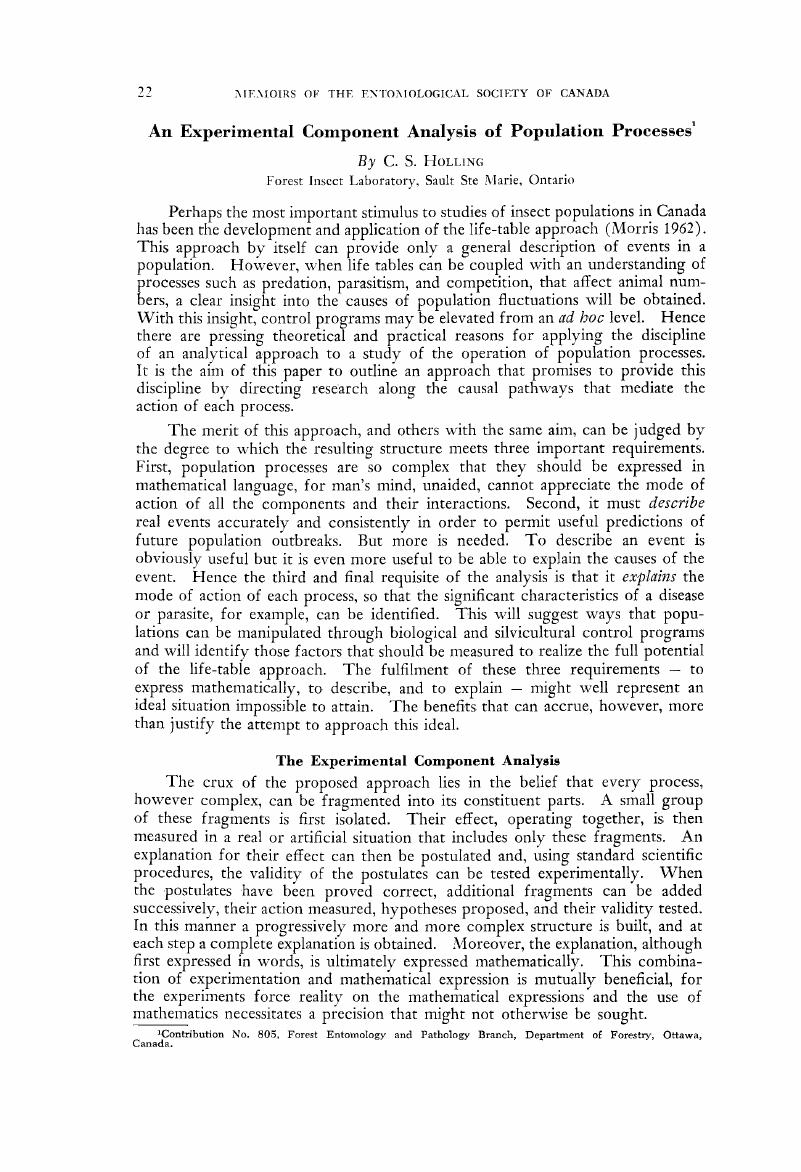Crossref Citations
This article has been cited by the following publications. This list is generated based on data provided by Crossref.
Watt, K. E. F.
1964.
The Use of Mathematics and Computers to Determine Optimal Strategy and Tactics for a Given Insect Pest Control Problem.
The Canadian Entomologist,
Vol. 96,
Issue. 1-2,
p.
202.
Holling, C. S.
1964.
The Analysis of Complex Population Processes.
The Canadian Entomologist,
Vol. 96,
Issue. 1-2,
p.
335.
VOûte, A.D.
1964.
Vol. 1,
Issue. ,
p.
325.
Holling, C. S.
1965.
The Functional Response of Predators to Prey Density and its Role in Mimicry and Population Regulation.
Memoirs of the Entomological Society of Canada,
Vol. 97,
Issue. S45,
p.
5.
Watt, K. E. F.
1965.
Community Stability and the Strategy of Biological Control.
The Canadian Entomologist,
Vol. 97,
Issue. 8,
p.
887.
Holling, Crawford S.
1966.
Systems Analysis in Ecology.
p.
195.
Holling, C. S.
1966.
The Functional Response of Invertebrate Predators to Prey Density.
Memoirs of the Entomological Society of Canada,
Vol. 98,
Issue. S48,
p.
5.
Reynoldson, T.B.
1966.
Advances in Ecological Research Volume 3.
Vol. 3,
Issue. ,
p.
1.
Southwood, T. R. E.
1967.
Problems and Possibilities in the Teaching of Ecology.
Journal of Biological Education,
Vol. 1,
Issue. 1,
p.
19.
Stiven, Alan E.
1967.
The influence of host population space in experimental epizootics caused by Hydramoeba hydroxena.
Journal of Invertebrate Pathology,
Vol. 9,
Issue. 4,
p.
536.
Messenger, P. S.
1968.
BIOCLIMATIC STUDIES OF THE APHID PARASITE PRAON EXSOLETUM: I. EFFECTS OF TEMPERATURE ON THE FUNCTIONAL RESPONSE OF FEMALES TO VARYING HOST DENSITIES.
The Canadian Entomologist,
Vol. 100,
Issue. 7,
p.
728.
Nakamura, Kazuo
1968.
The ingestion in wolf spiders I. Capacity of gut of Lycosa pseudoannulata.
Population Ecology,
Vol. 10,
Issue. 1,
p.
45.
Wilbert, Hubert
1970.
Feind-Beute-Systeme in kybernetischer Sicht.
Oecologia,
Vol. 5,
Issue. 4,
p.
347.
GLASS, NORMAN R.
1971.
Systems Analysis and Simulation in Ecology.
p.
325.
Nakamura, Kazuo
1972.
The ingestion in wolf spiders II. The expression of degree of hunger and amount of ingestion in relation to spider's hunger.
Population Ecology,
Vol. 14,
Issue. 1,
p.
82.
Stiven, Alan E.
1973.
Vol. 2,
Issue. ,
p.
145.
Dill, Lawrence M.
1973.
An avoidance learning submodel for a general predation model.
Oecologia,
Vol. 13,
Issue. 4,
p.
291.
Krebs, John R.
1973.
Perspectives in Ethology.
p.
73.
Streifer, William
1974.
Advances in Ecological Research Volume 8.
Vol. 8,
Issue. ,
p.
199.
Smith, R.H.
and
Mead, R.
1974.
Age structure and stability in models of prey-predator systems.
Theoretical Population Biology,
Vol. 6,
Issue. 3,
p.
308.





